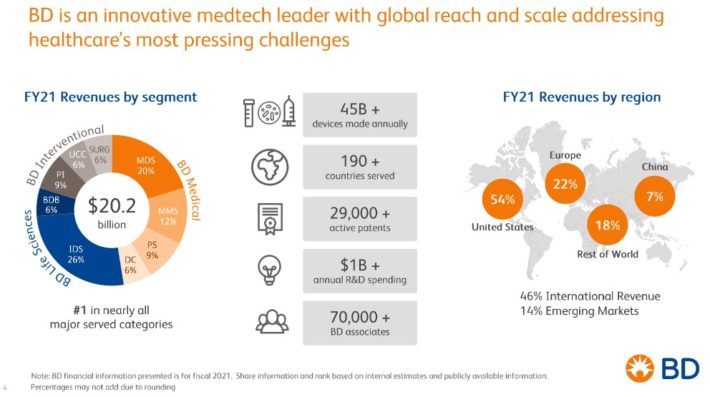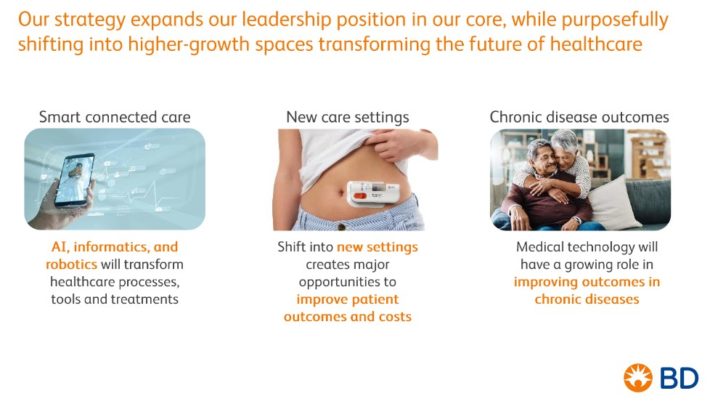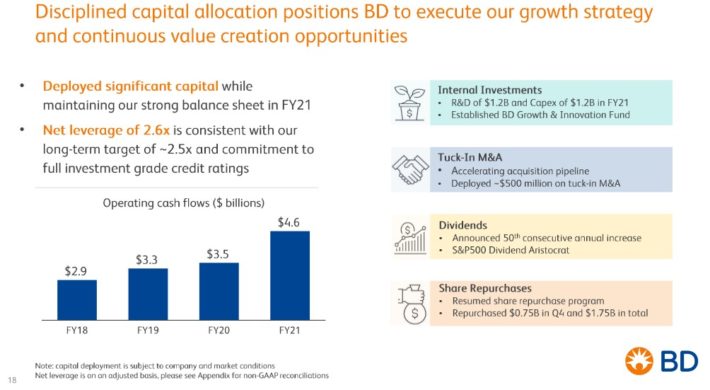Dividend Kings In Focus: Becton, Dickinson & Company
Becton, Dickinson & Company (BDX) recently increased its dividend for its 50th consecutive year. As a result, it has joined the exclusive list of Dividend Kings. The Dividend Kings have raised their dividend payouts for at least 50 consecutive years. You can see all 35 Dividend Kings here.
BDX has maintained its long history of dividend increases thanks to a superior position in its industry. Its competitive advantages have fueled the company’s long-term growth.
As we see the potential for continued growth in the healthcare industry, BDX should keep increasing its dividend each year. This article will discuss BDX’s business model, growth catalysts, and expected returns.
Business Overview
Becton, Dickinson & Company is a global leader in the medical supply industry. The company was founded in 1897 and today operates in 190 countries, generating annual sales above $19 billion. Nearly half the company’s revenue comes from outside the U.S.
The company operates three segments. First, the Medical Division provides needles for drug delivery systems, and surgical blades. The Life Sciences division provides products for the collection and transportation of diagnostic specimens. Lastly, the Intervention segment includes several of the products produced by what used to be Bard.
In all, BDX generates over $20 billion in annual revenue, nearly half of which is derived from outside the U.S.

Source: Investor Presentation
BDX released earnings results for the fourth quarter and fiscal year 2021 on Nov. 4, 2021 (the company’s fiscal year ends Sept. 30). Revenue grew 7.5% to $5.1 billion, beating estimates by $230 million.
Adjusted earnings–per–share of $2.59 compared unfavorably to adjusted earnings–per–share of $2.79 in the prior year, but was $0.14 better than expected. For the year, revenue grew 18.4% to $20.3 billion. Adjusted earnings–per–share of $13.08 saw a 28.2% increase from the prior year.
Each segment performed well. Medical segment sales grew 7.7% to $2.5 billion due to gains in medication delivery solutions and pharmaceutical systems. Life Science was up, when not including COVID–19 testing, to $1.5 billion. Lastly, its Interventional segment revenue increased 8.3% to $1.1 billion.
Each region once again showed growth. U.S. revenue increased 1%, while international markets were up 11.3%. The company offered guidance for fiscal year 2022, expecting adjusted earnings–per–share of $12.30 to $12.50 for the year.
Growth Prospects
Healthcare stocks like BDX are typically purchased for their steady long-term growth. BDX is no exception; the company has grown earnings-per-share by 10% per year in the past decade.
Going forward, we expect the company to post a similar 10% annual EPS growth rate over the next five years. Broadly, this growth will be achieved thanks in large part to the aging U.S. population.
The U.S. is an aging population, meaning demand for healthcare supplies is only expected to rise going forward. Total U.S. health expenditures are expected to total $4.22 trillion in 2021. Healthcare spending is expected to rise to $5.55 trillion in 2026, representing 5.6% annual growth.
This should be a broad tailwind that major healthcare manufacturers like BDX will benefit from. BDX continues to invest heavily in product innovation, which is critical to the company meeting its long-term growth objectives.

Source: Investor Presentation
Share repurchases will be an additional catalyst for earnings-per-share growth. Along with the recent ~5% dividend hike, BDX management also announced a new 10 million share repurchase authorization. This new authorization is in addition to the approximately 750,000 shares that remain available under the board’s previous authorization in 2013.
BDX ended the most recent quarter with just over 288 million diluted shares outstanding. Therefore, the new share repurchase authorization represents approximately 3.5% of the company’s current diluted share count.
As a result, if executed over the next few years, it is possible that the new share repurchase could add around a percentage point to the company’s annual earnings-per-share growth.
Competitive Advantages & Recession Performance
Becton, Dickinson & Company has significant competitive advantages, including scale and a vast patent portfolio. These competitive advantages are due to high levels of investment spending.
BDX spends over $1 billion each year in research and development. This investment is critical to the company’s ability to generate long-term growth, and maintain its industry leadership. The company aims for a balanced capital allocation structure.

Source: Investor Presentation
It is clear that its R&D spending has paid off, as the company possesses over 27,000 active patents. These competitive advantages provide the company with consistent growth, even during economic downturns.
Becton Dickinson steadily grew earnings during the Great Recession. Becton Dickinson’s earnings-per-share during the recession are as follows:
- 2007 earnings-per-share of $3.84.
- 2008 earnings-per-share of $4.46 (16% increase).
- 2009 earnings-per-share of $4.95 (11% increase).
- 2010 earnings-per-share of $4.94 (0.2% decline).
Becton Dickinson generated double-digit earnings growth in 2008 and 2009, during the worst years of the recession. It took a small step back in 2010, but continued to grow in the years since, along with the economic recovery. The ability to consistently grow earnings each year of the Great Recession, which was arguably the worst economic downturn in decades, is extremely impressive.
The company continued to perform well in 2020, when the coronavirus pandemic caused the U.S. economy to enter a recession. BDX remained highly profitable and was able to keep its dividend increase streak alive.
The reason for its recession resilience is that health care patients need medical supplies regardless of the state of the broader economy. This keeps demand steady from year to year.
Valuation & Expected Returns
We expect BDX to generate earnings-per-share of $12.40 this year. As a result, the stock has been recently trading at a price-to-earnings ratio of 19.9. We consider 18.6 to be a fair earnings multiple for this stock, which matches the 10-year average multiple. As a result, we view BDX stock as slightly overvalued right now.
If the P/E multiple declines from 19.9 to 18.6 over the next five years, shareholder returns would be reduced by 1.3% per year. However, dividends and earnings-per-share growth will boost shareholder returns. BDX shares currently yield 1.4%. And, we expect 10% annual EPS growth over the next five years.
Putting it all together, BDX stock is expected to generate annual returns of 10.1% over the next five years.
Final Thoughts
After raising its dividend in November, BDX is now a member of the exclusive Dividend Kings list. It has maintained 50 consecutive years of dividend increases due to its top position in the healthcare industry.
And, thanks to the aging U.S. population, the company should benefit from this long-term growth catalyst. This should allow BDX to continue raising its dividend for many years to come. In addition to being a strong dividend growth stock, BDX is reasonably valued. We see the potential for annual returns just above 10%, making BDX stock a buy.
Disclaimer: Sure Dividend is published as an information service. It includes opinions as to buying, selling and holding various stocks and other securities. However, the publishers of Sure ...
more


